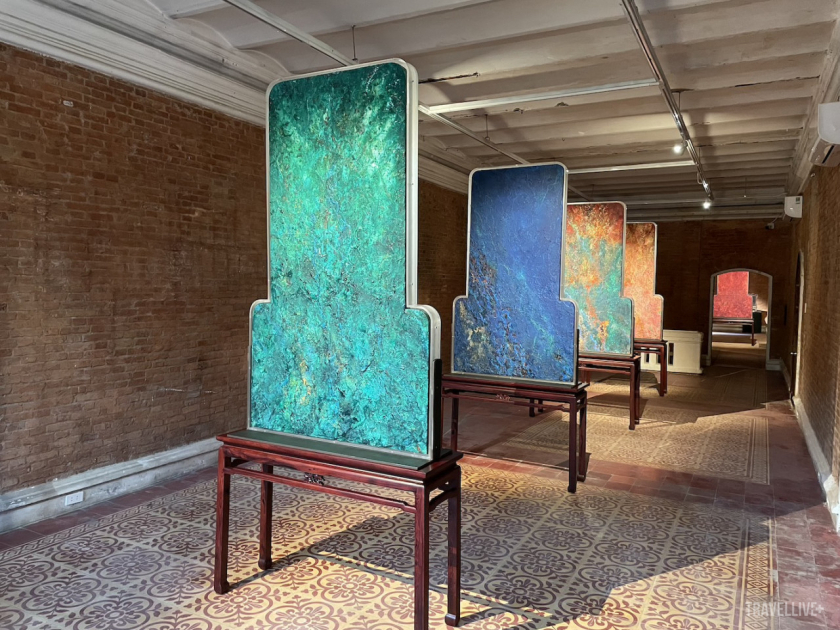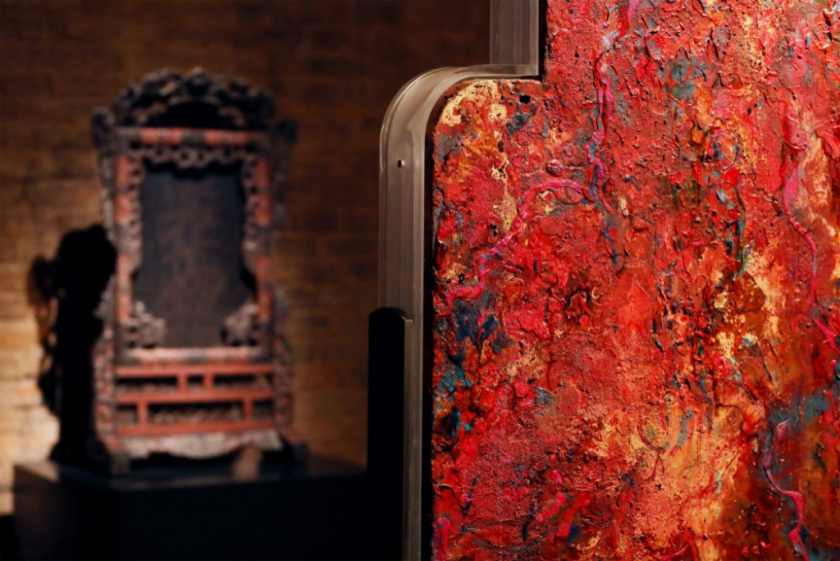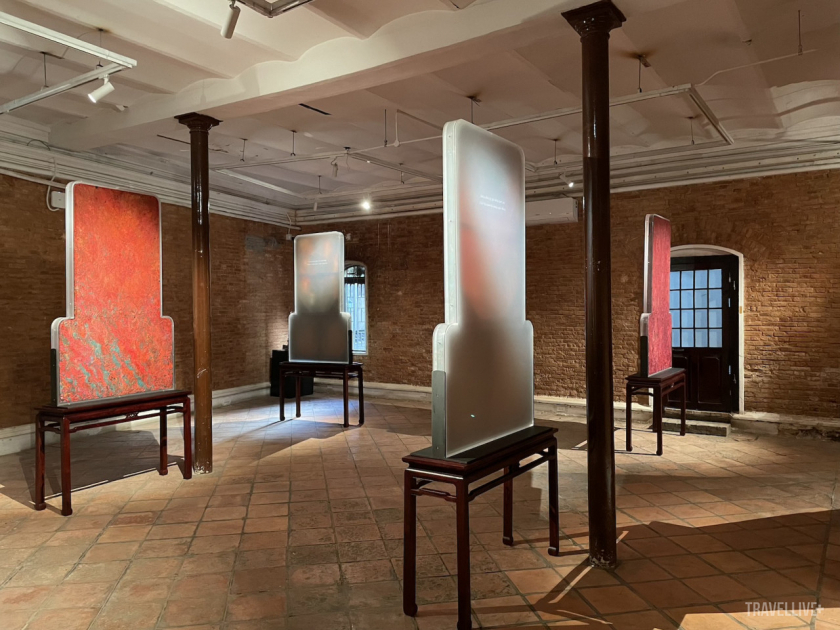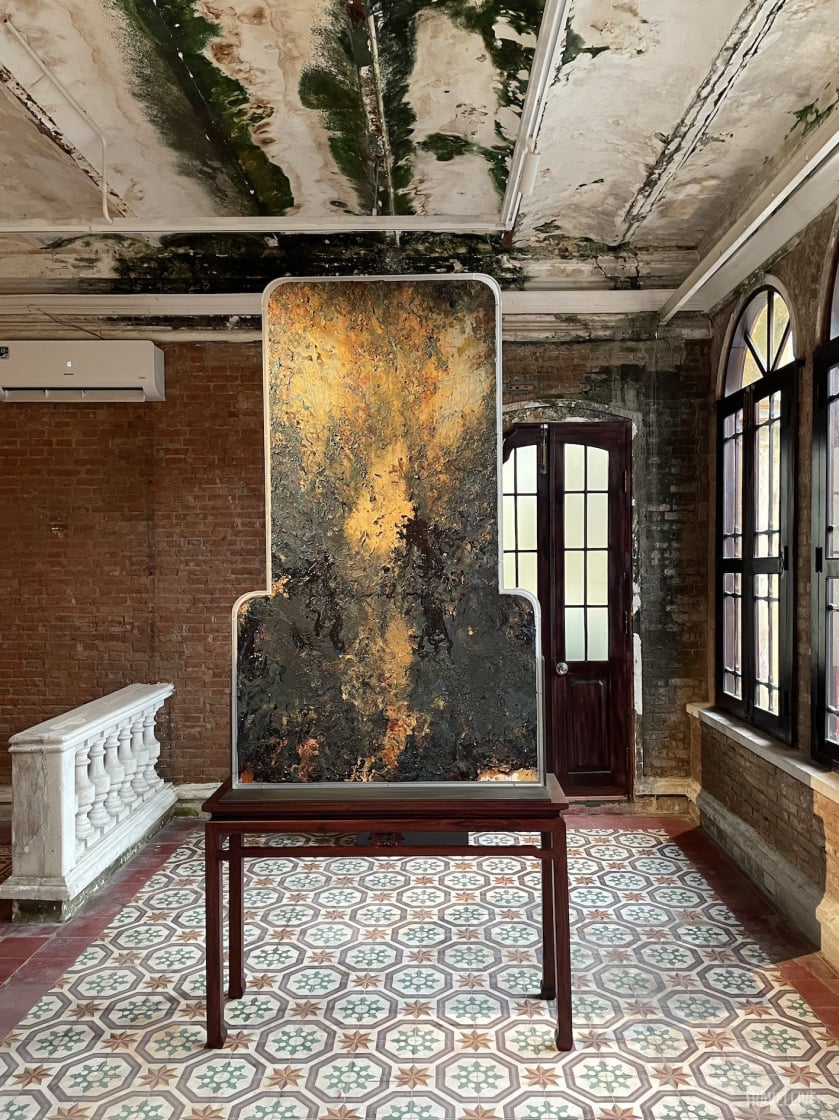Sky, Buddha scene,
The beast Huong Son has longed for.
Look at the mountains, the water, the clouds,
The first question is this?
(Huong Son Landscape Song - Chu Manh Trinh)
Inside the colonial architecture that used to be the guest house of the Sri Thendayuthapani Hindu temple, the exhibition Kia Non Non Nuoc Nuoc May May was born from the poetic idea in the poem Huong Son Phong Canh Ca by Chu Manh Trinh - a famous scholar of the Nguyen Dynasty. The verse describes the beautiful nuances of nature, moving many readers. This emotion is also expressed throughout Ha Manh Thang's artistic observations. At the exhibition, he exploited the polysemy, the historical change in the perspective on the form of landscape painting from ancient art to the present.

The poem "Look at the mountains, water, water, clouds" by Ha Manh Thang was born from the poetic idea in the poem "Huong Son Phong Canh Ca" by Chu Manh Trinh.
Ha Manh Thang and poetic paintings
Ha Manh Thang graduated from the Hanoi University of Fine Arts in 2004. In his previous works, the color palette he chose tended towards bright colors and pop art elements. In "Kia Non, Nuoc Nuoc, May May", his color palette is somewhat quiet.
As a person who loves and studies ancient cultural heritages, Ha Trong Thang is always impressed by the way the ancients looked at and expressed their style through set-ups, screens, and ancient poetry. The landscapes in set-ups and screens are often simplified in detail, not following the rules of perspective. Therefore, the subjects are simultaneously hidden or visible on the painted background.

As a person who loves and learns about ancient cultural heritages, Ha Trong Thang is always impressed by the way ancient people looked and expressed their style through landscapes, screens and ancient poetry.
Turn silk into stone
During a visit to the Vietnam History Museum in Hanoi, the author came across an ancient stone stele dating back to the Sui Dynasty (581 - 618). In the history of East Asian culture, their shape usually has three parts: the forehead; the rounded base, which in the past could be the shape of a turtle's back, a lotus pedestal... The inside of the stele is engraved with important information that has a social impact, such as morality, literary works, and achievements to be passed down to future generations. Ha Manh Thang used the shape of the ancient stone stele to reflect the longevity and timelessness of this series of works.

His "steles" come from a combination of silk, canvas with complex materials such as acrylic paint, lacquer, gold leaf and metallic glitter scattered on the painting.
The special thing about Ha Manh Thang's works lies in the materials. His "steles" come from a combination of silk, canvas with complex materials such as acrylic paint, lacquer, gold leaf and metallic glitter scattered on the painting. Thanks to the translucent properties of silk, the surface of the stele will change based on the movement of light. Notably, the back of each work is a layer of translucent mica, laser-engraved with the artist's favorite ancient poems.

In particular, the back of each work is a layer of frosted mica, laser-engraved with the artist's favorite ancient poems.
With Ha Manh Thang's treatment, art historian Nora Taylor observed and commented on the nature of the materials he used: "How can silk be both transparent and translucent? Light as a feather and heavy as a rock? The pull of the universe is revealed as two opposing forces of yin and yang."
Different from the traditional way of using silk, Ha Manh Thang has turned silk into a durable surface for the layers of paint to be covered and anchored. The surface treatment makes the work look like stone. The sixteen paintings in "Kia non, nuoc nuoc, may may" are part of the series of works "Circle of Time" that he has been creating since 2016. Each work is a journey to discover the eternity and timelessness in Ha Manh Thang's art.

Each work is a journey to discover the eternity and timelessness in art of Ha Manh Thang.
The living space of a work
Ha Manh Thang suggests to the audience to see his paintings: “If possible, come to the exhibition when it is still sunny. Natural light will reflect on the surface of the work – the front has metallic particles, the back has patches of color that 'fall' off the thin silk layer. And when the light changes during the day, there will be strong and continuous changes on the work, affecting the entire exhibition space. That is what I want in this exhibition, I want to see the works in natural sunlight like that.”

Ha Manh Thang suggests that the audience should see his paintings while it is still sunny.
Artist Ha Manh Thang wants his works to be as close to the environment that created them as possible. Sharing about the space of Kia Non Non Nuoc Nuoc May May, Ha Manh Thang feels that the four red brick walls and the ceiling covered with green moss bring a sense of connection to his works: "I can connect with this space, perhaps because I have the ability to create a layer of green moss, a layer of copper rust, an old look like this house."






























